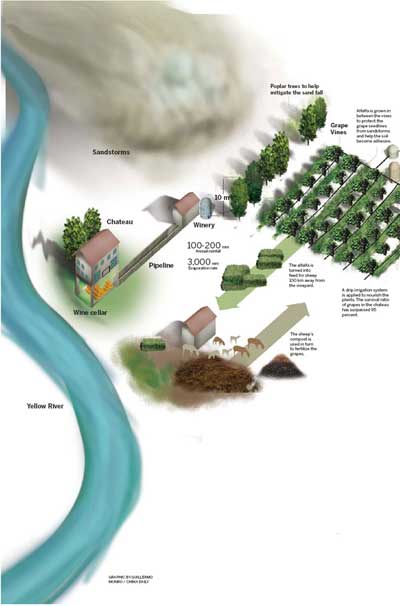
|
A vineyard is greening Inner Mongolia's desert while producing high-quality wines. WangKaihao and Yang Fang report in Wuhai, Inner Mongolia. It looks like a mirage. A five-story European-style chateau stands in the Ulan Buh Desert flanked by the HelanMountains, which run south for 200 kilometers and are bisected by the Yellow River. The villa issurrounded by verdant landscapes. This oasis is host to a 250-hectare vineyard surrounded by poplar thickets. The ChateauHansen produces more than 10,000 tons of wine a year from what was barren sand less than adecade ago. "We'd been trying various methods, such as planting trees and bushes, to combatdesertification for years," the vineyard's deputy director Li Aixin says. "But these government-led initiatives didn't embrace the market and didn't gain traction. Wecan't sacrifice our ecology for profits, but it's equally unwise to ignore economic opportunitiesand solely rely on selfless dedication." Wuhai has an abundance of annual sunshine - up to 3,200 hours. Its latitude is similar toFrance's Bordeaux and California's Napa Valley. The vast temperature differences within the24-hour cycle are conducive to the grapes' sugar accumulation. The city was built around large-scale coal mines in the 1950s. Migrants brought grape seeds, and local families often trellised their back yards and grewvines. Vineyards were common in the city. But only 65 percent of grapes survived past a year because soil salinization hovered aroundpH 8 and temperatures plummet to -30 C in winter. Grapes had to be replanted annually, whiletop-tier wines usually comes from aged vines. Technicians in Li's team grafted French varieties, including Cabernet Sauvignon, CabernetFranc and Merlot, on roots from local wild grapes to create hybrids. They also grew breeds common to China for comparison. Though the new varieties grewslower in the first year, they struggled to survive and bloomed. Others gradually withered. Annual rainfall in the region is 100-200 mm, but evaporation exceeds 3,000 mm. And the precipitation that soaks the ground seeps through the vineyard's sand withoutnourishing the plants. An Israeli drip irrigation system was introduced, and the survival raterocketed to 95 percent. "If you drop a grape seed in a southern province, it will easily grow into a vine," Li says. "But our varieties are much stronger against cold, disease and other ecological inhospitalities.It's not good to always protect plants in greenhouses." Sandstorms pose the greatest threat to seedlings. "No matter how we grow the plants, sandstorms can blast or bury, and kill them," Li says. Poplars became the first shield. But the 10-meter-high trees only blunted the force of the sandblasts, and many seedlings stilldied. In 2008, the vineyard piloted the method of growing grapesand alfalfa on the same ridge. Alfalfa proved to be the fragile grapevines' effectiveguardian. The herb typically lives 5-7 years,providing grapevines time to grow strong enough tosurvive sandstorms. Alfalfa stalks are buried toenhance fertility. "You must respect nature's rules," Li says. "If you cheat soil, it cheats you back. Using scientificapproaches to adapt can best reap nature'srewards." Alfalfa's rewards are the rich nitrogen it gives soiland the nutrition it offers sheep. Sheep have longbeen a staple of the area's largely nomadic herdingeconomy. The vineyard produces 100 tons of alfalfa annuallyin addition to 500 tons of grapes. The alfalfa is sentto a sheep farm 100 km away and returns asmanure that fertilizes organic grapes. The vineyard is set to expand its claim on thedesert, with a 13-hectare poplar and pagoda treenursery. This not only improves the local environment butalso provides economic opportunities to migrantsdriven off their land by ecological hardships. Chen Huizi, a native of Qingyang, Gansu province, struggled with unstable corn yields in herdry and marginally arable hometown. She came to the vineyard in 2008 and trained to become a grape farmer. "We used to depend entirely on nature's mercy," she recalls while pruning a vine. "A stable salary is a blessing." This small self-sustaining ecosystem has been replicated in three larger vineyards with similarhabitats west of Wuhai, in neighboring Ordos and in the Ningxia Hui autonomous region'sWuzhong. The model now covers more than 6,600 hectares. Inner Mongolia University biology professor and Hansen's cultural director Xue Xiaoxianexplains: "The word 'chateau' is usually misunderstood. People usually think of a castle withcellars. Instead, it's an essential form of agriculture." Chateau's Chinese translation - jiuzhuang - literally means "wine manor". "This is a carbon-reduction industry that's one step ahead of the low-carbon model," Xue says. "Grapes are a long-term investment. We've just begun to see results." This progress encourages Chinese winemakers long frustrated with the country's inability toproduce internationally acclaimed wines. "Chinese wine is neglected in overseas markets because its production bases lack uniquecharacteristics," says winemaker Kang Dengzhao, who's also chief technical engineer of thewinery in Hansen. "Wineries often collect grapes from individual growers, making it difficult to stick to a singlestandard. Sometimes the more grapes are grown, the poorer the quality. "But our desert grapes are distinctive." |
内蒙古自治区乌海市北郊,贺兰山余脉和黄河在这里交汇,绵延的是乌兰布和沙漠。略显苍凉的景致中,一幢五层的西式洋楼宛若海市蜃楼。这里是汉森沙漠有机酒庄。 这块3700亩的绿洲由杨树环抱,里面是一片郁郁葱葱的葡萄园。如今的酒庄让人很难相信十年前这里还是漫天黄沙的不毛之地。 “这么多年以来,我们采取了很多方法来治沙,比如种树、栽培灌木等等,”汉森下属的葡萄种植公司副总经理李埃新回忆道。“但是这些政府主导的运动往往缺乏市场的参与,这样吸引力也大打折扣。我们不能为了赚钱牺牲生态环境,但是现如今为了恢复生态,讲求不计回报的无私奉献也已经不大现实。” 乌海阳光充足,一年的日照时数差不多有3200小时。乌海的纬度和世界著名的葡萄产区法国波尔多和加州的纳帕酒庄相近。同时这里巨大的日夜温差也非常有利于葡萄中的糖分沉淀,对于优质葡萄的种植来说,乌海再适合不过。 乌海的城市建设始于上世纪五十年代,当时大型煤矿的开采吸引了全国各地的移民蜂拥而至。他们也带来了葡萄种子,当地人后院的葡萄架成为了一大景观。而之后大大小小的葡萄园也渐渐兴起。可是由于当地土质的盐碱化(pH值约为8)和冬季动辄零下二三十度的低温使得葡萄的成活率仅仅约为65%。上等的葡萄酒要求产自树龄较长的葡萄,而乌海很多种植户只能年年砍掉死掉的葡萄藤再种上新的,这也成为了当地葡萄产业发展的一大制约。 李埃新的技术团队于是引进诸如赤霞珠、品丽珠、梅洛等法国葡萄品种,将它们与本地适应力较强的野生葡萄进行嫁接用以培育新的品种。同时他们也同期种植一些中国常见的葡萄品种进行比较。这些新的嫁接品种在第一年旺旺长势不如其他品种,但是随后几年却开始茁壮成长,而在恶劣的沙漠环境中,其他品种的葡萄却渐渐枯萎。 缺水是另一个问题。乌海的年降水量大约在100至200毫米之间,但是年蒸发量却在3000毫米以上。这稀缺的降水也会很快渗入当地的沙质土壤当中,无法起到滋润植物的作用。于是,葡萄园从以色列引进了先进的滴灌设备,葡萄的成活率也已经超过了95%。 “在南方省份,你往地里随便丢个种子都能结出果子,”李埃新说。“但是这里的葡萄更耐寒、耐病虫害,可以适应各种恶劣的环境。植物在温室里待久了对自己也没有啥好处。” 然而,频繁造访的沙尘暴对于葡萄苗来说又是一大威胁。 “不管我们对葡萄多么悉心照料,只要沙暴一来把苗都埋了,所有努力就白费了。” 杨树于是成为了保护葡萄园的第一道屏障,但是无法彻底解决沙暴的侵扰,因为部分沙子仍然会透过树木之间的空隙对弱小的幼苗带来致命打击。2008年,葡萄园里开始了一种新的尝试:在葡萄周围种上苜蓿。苜蓿是内蒙古地区牧草的主要品种,事实证明它是葡萄苗的有力保护者。苜蓿的生长周期大约是五到七年,这么长足够让葡萄生长到强壮得足以抵御风沙的程度。牧草的秸秆也可以大大提高土壤的肥力。 “我们必须尊重自然的法则,”李埃新说。“你若骗地,地一定骗你。用一些科学的手段利用自然因势利导便会得到回报。” 每年葡萄园产出500吨的葡萄同时也可以产出100吨左右的牧草。这些牧草被送往100多公里以外的一个养羊场,而这些羊也可以提供羊粪蛋作为葡萄种植的有机肥。这块种植园里所有的葡萄用的都是有机肥。 同时,这里还有一个200亩的苗圃,培育杨树、槐树等树苗,逐步改造沙地,扩大葡萄园的面积。 而这样的生态经济已经不仅仅造福当地,也给几百名来自外地的务工者提供了就业机会。 陈会紫是来自甘肃庆阳的农民,2008年来到乌海。她的老家地处黄土高原,气候干旱。她种了玉米,但是产量非常不稳定。 “一切都是靠天收,”陈会紫一边给葡萄修枝一边说。“在这里一个月2000块的工资已经很好了。” 这样的循环经济模式已经开始在邻近的沙漠地区推广,汉森酒庄目前已经有其他三个葡萄园。一个在乌海市的乌达区,一个在鄂尔多斯,另一个在宁夏吴忠,总共面积近十万亩。 薛晓先,内蒙古大学教授,同时也是汉森酒庄的文化与品牌总监。 “很多中国人对于酒庄这个词有误解,”他解释说。“很多人以为有酒窖,有城堡那才叫酒庄。其实本质上来说,酒庄也是农业的一种。这里进行的是减碳经济,比现在流行的低碳经济更进一步。但是种葡萄需要长期的投资,很难立竿见影,现在才刚刚看到成效。” 这一切成就也鼓舞着当地的酿酒师。我国的酿酒师经常因为缺乏具有世界影响力的葡萄酒品牌而困扰。 “中国葡萄酒在海外市场影响力还不够,其中一个原因是各个产区大多缺乏自己的特色,雷同度太高,”康登昭是汉森葡萄酒厂的技术总工。“另外,很多酒厂从个体种植户手中收购葡萄,这样很难执行统一的标准,也很难质量监控。有时候葡萄种的越多品质却越差。” “但是这生长在沙漠的葡萄却与众不同,也解决了质量监控的问题,”康登昭高兴地说。 相关阅读 (中国日报记者 王恺昊 杨芳 编译) |